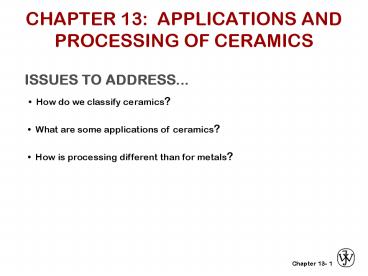CHAPTER 13: APPLICATIONS AND PROCESSING OF CERAMICS - PowerPoint PPT Presentation
1 / 18
Title:
CHAPTER 13: APPLICATIONS AND PROCESSING OF CERAMICS
Description:
What are some applications of ceramics? How is processing different ... Courtesy Martin Deakins, GE Superabrasives, Worthington, OH. Used with permission. ... – PowerPoint PPT presentation
Number of Views:527
Avg rating:3.0/5.0
Title: CHAPTER 13: APPLICATIONS AND PROCESSING OF CERAMICS
1
CHAPTER 13 APPLICATIONS AND PROCESSING OF
CERAMICS
ISSUES TO ADDRESS...
How do we classify ceramics?
What are some applications of ceramics?
How is processing different than for metals?
1
2
TAXONOMY OF CERAMICS
Adapted from Fig. 13.1 and discussion in Section
13.2-6, Callister 6e.
Properties --Tmelt for glass is moderate,
but large for other ceramics. --Small
toughness, ductility large moduli creep
resist. Applications --High T, wear
resistant, novel uses from charge neutrality.
Fabrication --some glasses can be easily
formed --other ceramics can not be formed or
cast.
2
3
APPLICATION REFRACTORIES
Need a material to use in high temperature
furnaces. Consider Silica (SiO2) - Alumina
(Al2O3) system. Phase diagram shows
mullite, alumina, and crystobalite (made up of
SiO2) tetrahedra as candidate refractories.
Adapted from Fig. 12.27, Callister 6e. (Fig.
12.27 is adapted from F.J. Klug and R.H. Doremus,
"Alumina Silica Phase Diagram in the Mullite
Region", J. American Ceramic Society 70(10), p.
758, 1987.)
3
4
APPLICATION DIE BLANKS
Die blanks --Need wear resistant
properties!
Adapted from Fig. 11.7, Callister 6e.
Courtesy Martin Deakins, GE Superabrasives,
Worthington, OH. Used with permission.
Die surface --4 mm polycrystalline
diamond particles that are sintered on to
a cemented tungsten carbide
substrate. --polycrystalline diamond helps
control fracture and gives uniform
hardness in all directions.
Courtesy Martin Deakins, GE Superabrasives,
Worthington, OH. Used with permission.
4
5
APPLICATION CUTTING TOOLS
Tools --for grinding glass, tungsten,
carbide, ceramics --for cutting Si wafers
--for oil drilling
Solutions --manufactured single crystal
or polycrystalline diamonds in a
metal or resin matrix. --optional coatings
(e.g., Ti to help diamonds bond to a Co
matrix via alloying) --polycrystalline
diamonds resharpen by microfracturing
along crystalline planes.
blades
oil drill bits
coated single crystal diamonds
polycrystalline diamonds in a resin matrix.
Photos courtesy Martin Deakins, GE
Superabrasives, Worthington, OH. Used with
permission.
5
6
APPLICATION SENSORS
Ex Oxygen sensor ZrO2 Principle
Make diffusion of ions fast for rapid
response. Approach Add Ca impurity
to --increase O2- vacancies
--increase O2- diffusion Operation
--voltage difference produced when
O2- ions diffuse between external
and references gases.
6
7
CERAMIC FABRICATION METHODS-I
GLASS FORMING
Pressing
Fiber drawing
Blowing
Adapted from Fig. 13.7, Callister, 6e. (Fig.
13.7 is adapted from C.J. Phillips, Glass The
Miracle Maker, Pittman Publishing Ltd., London.)
7
8
GLASS STRUCTURE
Basic Unit
Glass is amorphous Amorphous structure
occurs by adding impurities (Na,Mg2,Ca2,
Al3) Impurities interfere with formation
of crystalline structure.
Quartz is crystalline SiO2
(soda glass)
Adapted from Fig. 12.11, Callister, 6e.
8
9
GLASS PROPERTIES
Specific volume (1/r) vs Temperature (T)
Crystalline materials --crystallize at
melting temp, Tm --have abrupt change in
spec. vol. at Tm
Glasses --do not crystallize --spec.
vol. varies smoothly with T --Glass
transition temp, Tg
Adapted from Fig. 13.5, Callister, 6e.
Viscosity --relates shear stress
velocity gradient --has units of (Pa-s)
9
10
GLASS VISCOSITY VS T AND IMPURITIES
Viscosity decreases with T Impurities lower
Tdeform
Adapted from Fig. 13.6, Callister, 6e. (Fig. 13.6
is from E.B. Shand, Engineering Glass, Modern
Materials, Vol. 6, Academic Press, New York,
1968, p. 262.)
10
11
HEAT TREATING GLASS
Annealing --removes internal stress caused
by uneven cooling. Tempering --puts
surface of glass part into compression
--suppresses growth of cracks from surface
scratches. --sequence --Result
surface crack growth is suppressed.
11
12
CERAMIC FABRICATION METHODS-IIA
PARTICULATE FORMING
Milling and screening desired particle size
Mixing particles water produces a "slip"
Form a "green" component
Adapted from Fig. 11.7, Callister 6e.
--Hydroplastic forming extrude the slip
(e.g., into a pipe)
--Slip casting
Adapted from Fig. 13.10, Callister 6e. (Fig.
13.10 is from W.D. Kingery, Introduction to
Ceramics, John Wiley and Sons, Inc., 1960.)
hollow component
solid component
Dry and Fire the component
12
13
FEATURES OF A SLIP
Clay is inexpensive Adding water to clay
--allows material to shear easily along
weak van der Waals bonds --enables extrusion
--enables slip casting
Structure of Kaolinite Clay
Adapted from Fig. 12.14, Callister 6e. (Fig.
12.14 is adapted from W.E. Hauth, "Crystal
Chemistry of Ceramics", American Ceramic Society
Bulletin, Vol. 30 (4), 1951, p. 140.)
13
14
DRYING AND FIRING
Drying layer size and spacing decrease.
Adapted from Fig. 13.11, Callister 6e. (Fig.
13.11 is from W.D. Kingery, Introduction to
Ceramics, John Wiley and Sons, Inc., 1960.)
Firing --T raised to (900-1400 C)
--vitrification glass forms from clay and flows
between SiO2 particles.
Adapted from Fig. 13.12, Callister 6e. (Fig.
13.12 is courtesy H.G. Brinkies, Swinburne
University of Technology, Hawthorn Campus,
Hawthorn, Victoria, Australia.)
14
15
CERAMIC FABRICATION METHODS-IIB
PARTICULATE FORMING
Sintering useful for both clay and non-clay
compositions. Procedure --grind to
produce ceramic and/or glass particles
--inject into mold --press at elevated T to
reduce pore size. Aluminum oxide powder
--sintered at 1700C for 6 minutes.
Adapted from Fig. 13.15, Callister 6e. (Fig.
13.15 is from W.D. Kingery, H.K. Bowen, and D.R.
Uhlmann, Introduction to Ceramics, 2nd ed., John
Wiley and Sons, Inc., 1976, p. 483.)
15
16
CERAMIC FABRICATION METHODS-III
CEMENTATION
Produced in extremely large quantities.
Portland cement --mix clay and lime bearing
materials --calcinate (heat to 1400C)
--primary constituents tri-calcium
silicate di-calcium silicate Adding
water --produces a paste which hardens
--hardening occurs due to hydration (chemical
reactions with the water). Forming
done usually minutes after hydration begins.
16
17
SUMMARY
Basic categories of ceramics --glasses
--clay products --refractories
--cements --advanced ceramics Fabrication
Techniques --glass forming (impurities
affect forming temp). --particulate forming
(needed if ductility is limited)
--cementation (large volume, room T process)
Heat treating Used to --alleviate residual
stress from cooling, --produce fracture
resistant components by putting surface
into compression.
17
18
ANNOUNCEMENTS
Reading
Core Problems
Self-help Problems
0

